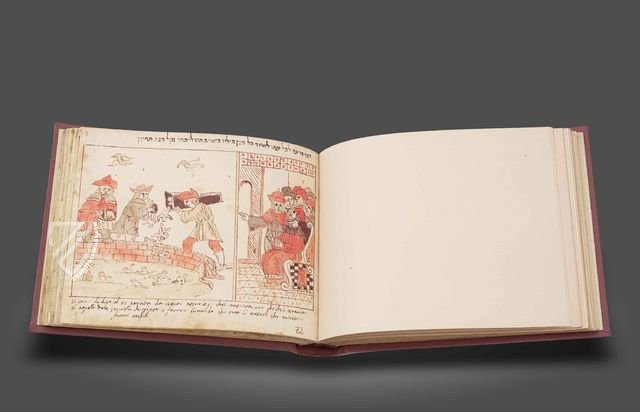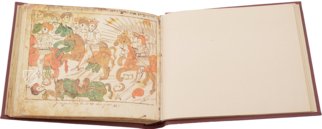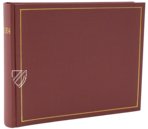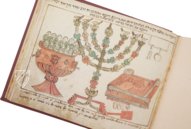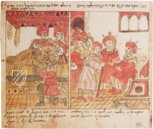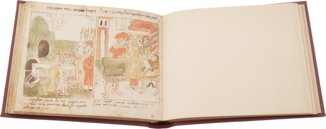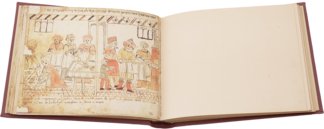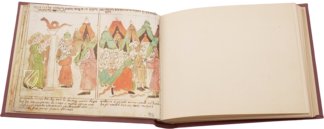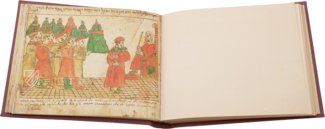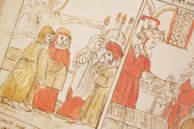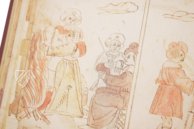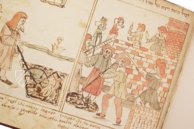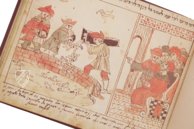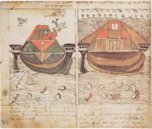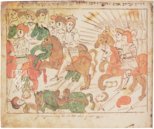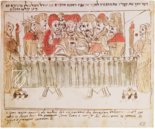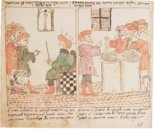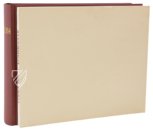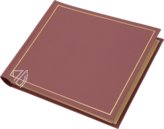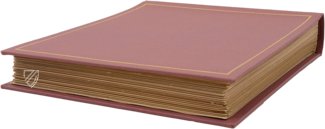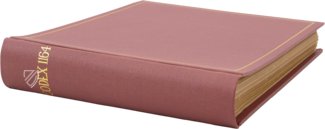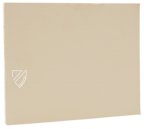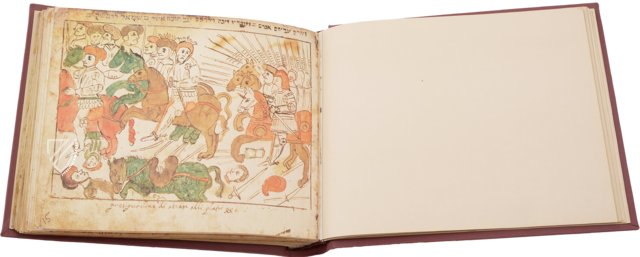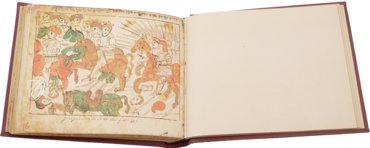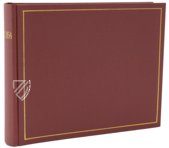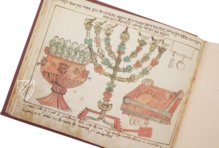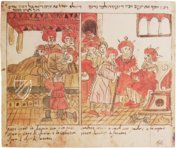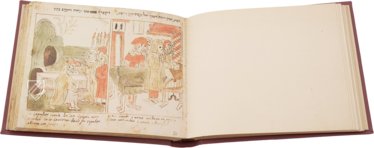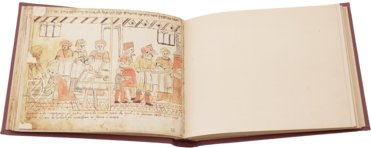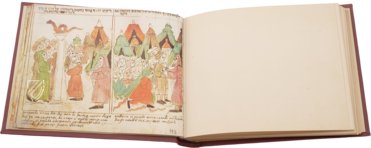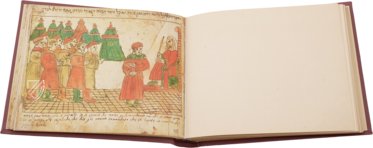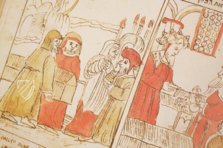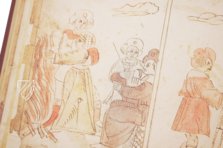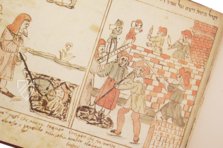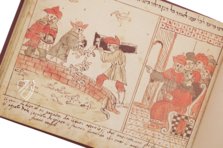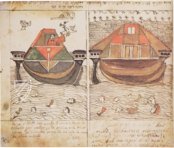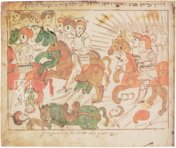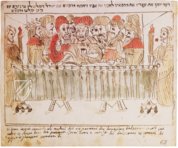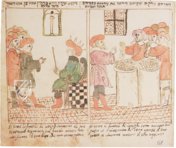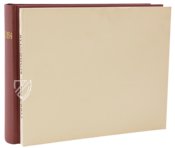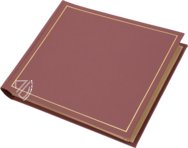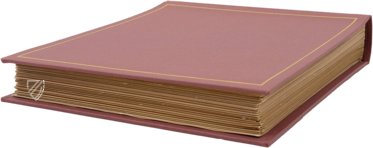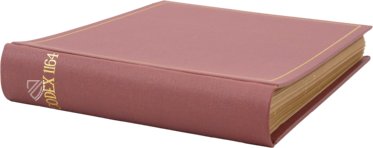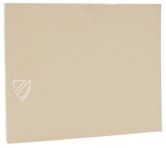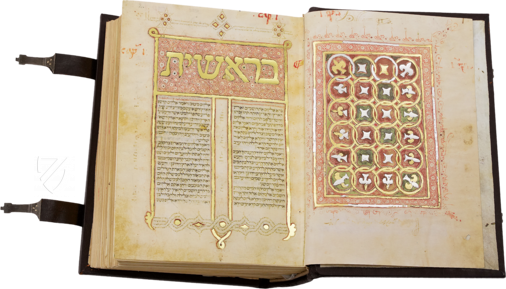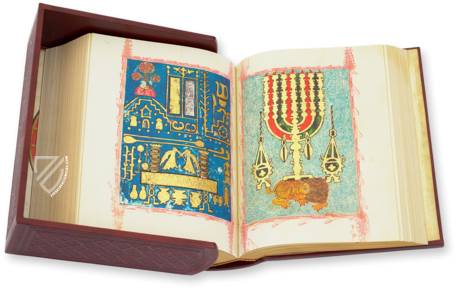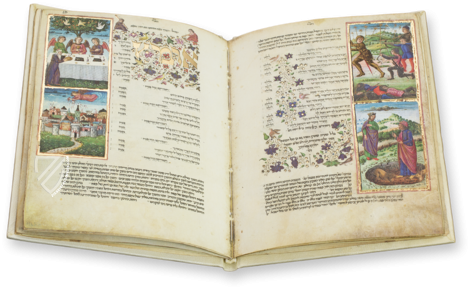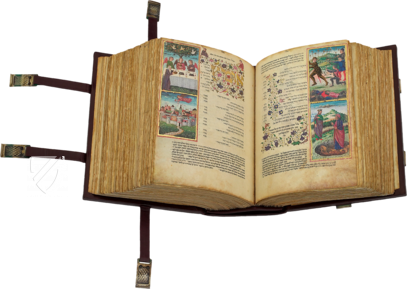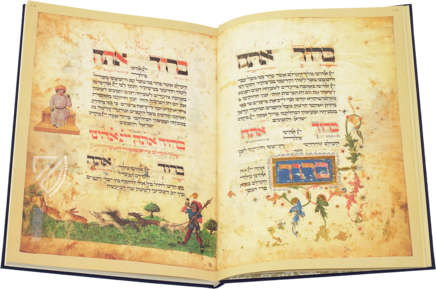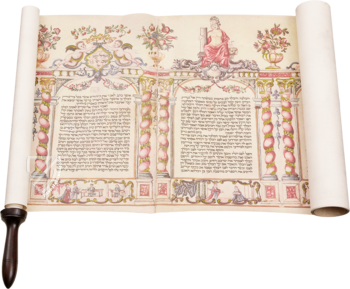Codex Choumach (Picture Pentateuch of Moses dal Castellazzo)
(1,000€ - 3,000€)
An extraordinary rarity: since the prohibition of images in the Decalogue was interpreted much more strictly in Judaism than in Christianity, a Jewish picture Bible should not actually exist. For this reason, Moses dal Castellazzo (1467-1527) needed an exceptional decision from the Venetian "Council of Ten" before the portrait painter and engraver, famous throughout Italy for his artistry, was allowed to express the essential statements of the Pentateuch in his moving colored pen drawings from 1521. They are surprisingly simple, sober, and so reduced to the essentials that they seem almost modern. Yet it is possible that it was precisely through his eye for the essentials in his pictures that the brilliant artist wanted to contribute to a new understanding of the Old Testament prohibition on images. Marginal notes in the Venetian dialect of the 16th century then also indicate that the owner of this particular work was a Christian bibliophile.
Bilder-Pentateuch des Moses da Castellazzo (Choumach-Codex)
The Picture Pentateuch of Moses dal Castellazzo is a Hebrew picture Bible telling the story of the first five books of the Old Testament (Pentateuch). Unlike an illustrated Bible in which the word of God is explained with images, it contains a series of images complete with explanatory legends and Bible verses as headings. The only Jewish parallels to this method of illustration is the Sephardic Pesach-Haggadot. The Warsaw codex is the unique copy of a series of woodcuts, now lost, by Moses dal Castellazzo. Some bibliophile, probably not Jewish but rather a Christian humanist, had it made in the mid–16th century. The pictures in this manuscript, which are outstanding in cultural history, are simple pen drawings colored only occasionally in red, brown, or green tones. The illustrated cycle begins with the Creation, followed by narratives of the five books, and ends with Moses’ death. Several pictorial traditions melt into a harmonious whole in the Picture Pentateuch of Moses dal Castellazzo. The work not only drew the attention of contemporaries, but still catches the interest of many today because of its originality. It is considered a monument which lowers the curtain on a dying epoch.
A Biblical Picture Book
The main feature of the Picture Pentateuch is not its text but its pictures, whose meanings are explained in a few lines. Moreover, the individual biblical events are not portrayed in a single illustration, but are frequently reproduced in a sequence of scenes showing the same protagonists at several stages of the narrative, in the manner of an illustrated chronicle. In line with Hebrew tradition, the pictures are to be read from right to left. The recto pages of the leaves usually have two separate pen drawings set in a frame, while the verso pages have been left blank. The upper margins in nearly all the pictures are filled with one or two lines of Hebrew text, passages of verses from the Bible referring to the picture below. The much larger lower margins of the pages almost always show legends in Italian, consisting of several lines and explaining or completing the picture situated immediately above. Occasionally, the text refers to particularities of the rabbinical tradition represented in the picture. The language is a 16th century Venetian dialect and the letter form also indicates the mid–16th century.
Moses dal Castellazzo
Moses dal Castellazzo was well known in Jewish circles as a painter who enjoyed great reputation. In a letter addressed to the Venice "Council of the Ten" in 1521, he mentioned that he produces woodcuts and requested the exclusive right to print and sell a woodcut series of the Pentateuch, a privilege that was finally granted to him. The printing method for woodcut had already been in use for half a century, when Johannes Gutenberg printed his first Latin Bible between 1452 and 1455. Moses dal Castellazzo used the same printing method to render the first five books of the Old Testament intelligible by means of pictures. He employed multiple sources, several picture Bible manuscripts and woodcut illustrations from early Venetian prints, to which he added contemporary elements, especially costumes. By doing so, Moses dal Castellazzo successfully saved the picture Bible tradition for the new age of printed books and, with the help of the new technology, created a printed, instead of a painted, picture Bible. The great enthusiasm for this woodcut series is not least evidenced by the existence of the Warsaw codex, which represents a copy of this unique document from the end of an era.
Codicology
- Alternative Titles
- Choumach-Codex
Bilder-Pentateuch des Moses da Castellazzo - Size / Format
- 246 pages / 24.1 × 19.5 cm
- Origin
- Italy
- Date
- 16th century
- Epochs
- Style
- Illustrations
- 123 full-page colored pen and ink drawings
- Artist / School
- Moses dal Castellazzo
Codex Choumach (Picture Pentateuch of Moses dal Castellazzo)
Noah's Ark
While the victims of the Flood float in the water, reminding the viewer of God's destructive power and power, a dove brings the hopeful message to Noah, who is standing at the window of his ark above: "Towards evening the dove came back to him and behold: And the dove came in to him in the evening; and, lo, in her mouth was an olive leaf pluckt off: so Noah knew that the waters were abated from off the earth." (Genesis 8:11)
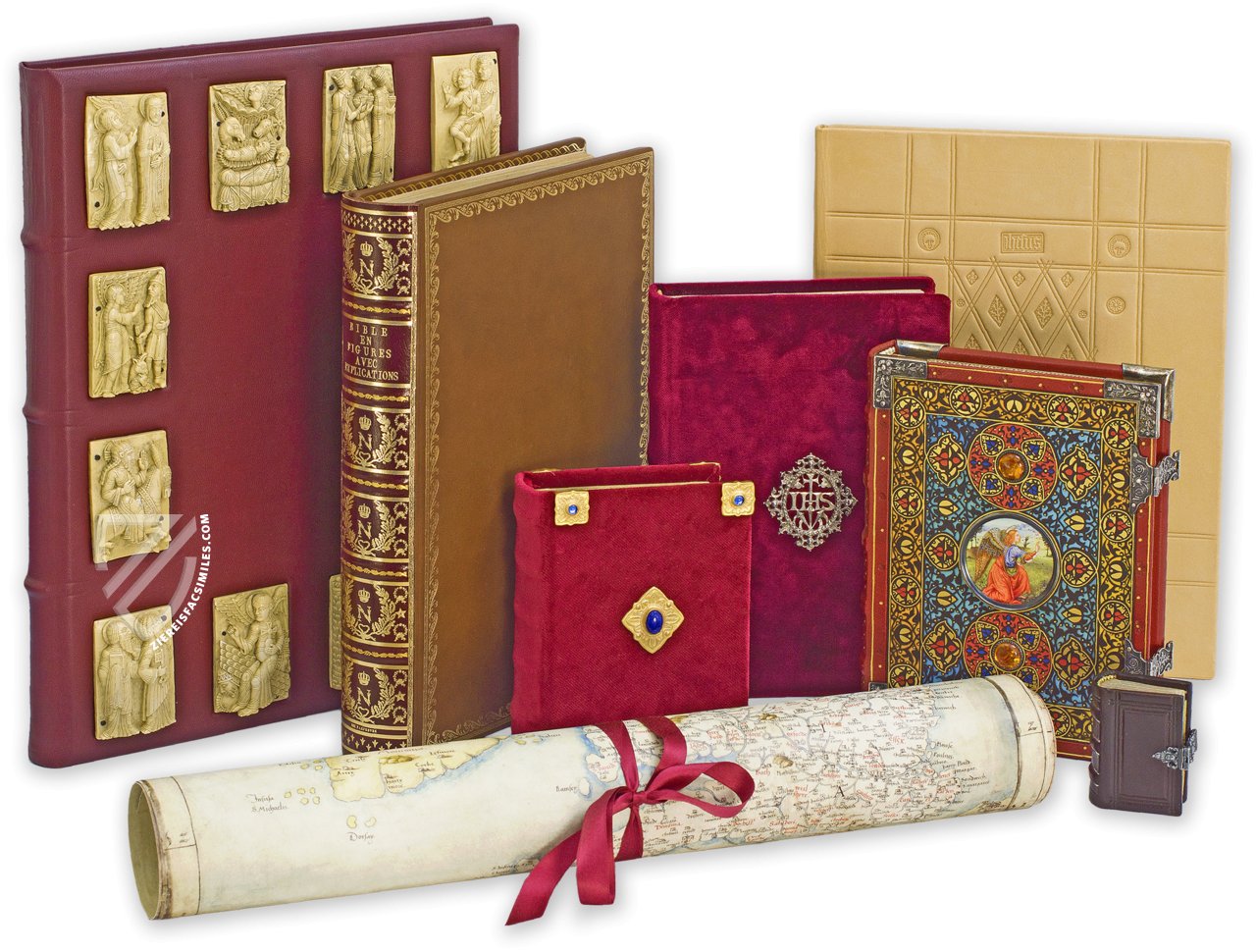
Codex Choumach (Picture Pentateuch of Moses dal Castellazzo)
Abraham's Fight for Lot
Several years ago, Lot had moved with his flocks into the fertile Jordan Valley when a war broke out between nine kings in the region: five against four. The victorious kings plunder, destroy and take Lot prisoner. A fugitive from the war tells Abraham, Lot's uncle, about the capture.
Abraham immediately sets off with his men, 318 in number, to free his nephew. The full-page miniature shows their battle against the four kings Kedor-Laomer, Tidal, Amrafel and Arjoch, one of whom has already fallen. Abraham appears on the right on a mighty warhorse, which at second glance turns out to be a unicorn.
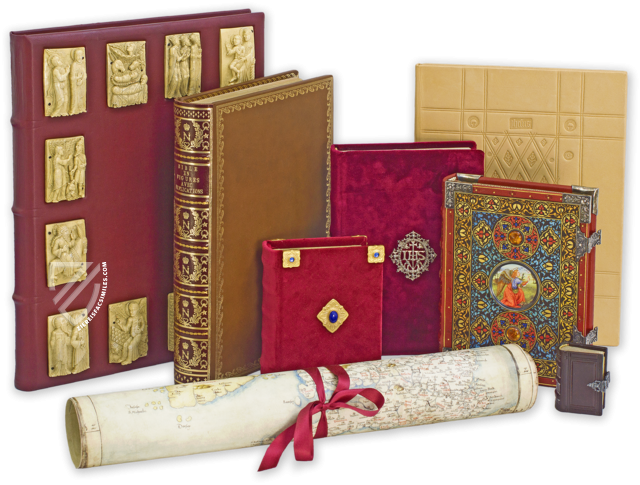
#1 Codex Choumach
Languages: German, French, Hebrew, Polish
Prepared by scholars of the Institute of Jewish Studies of the University in Vienna under the direction of Kurt and Ursula Schubert and other internationally known researchers.
(1,000€ - 3,000€)
- Treatises / Secular Books
- Apocalypses / Beatus
- Astronomy / Astrology
- Bestiaries
- Bibles / Gospels
- Chronicles / History / Law
- Geography / Maps
- Saints' Lives
- Islam / Oriental
- Judaism / Hebrew
- Single Leaf Collections
- Leonardo da Vinci
- Literature / Poetry
- Liturgical Manuscripts
- Medicine / Botany / Alchemy
- Music
- Mythology / Prophecies
- Psalters
- Other Religious Books
- Games / Hunting
- Private Devotion Books
- Other Genres
- Afghanistan
- Armenia
- Austria
- Belgium
- Belize
- Bosnia and Herzegovina
- China
- Colombia
- Costa Rica
- Croatia
- Cyprus
- Czech Republic
- Denmark
- Egypt
- El Salvador
- Ethiopia
- France
- Germany
- Greece
- Guatemala
- Honduras
- Hungary
- India
- Iran
- Iraq
- Israel
- Italy
- Japan
- Jordan
- Kazakhstan
- Kyrgyzstan
- Lebanon
- Liechtenstein
- Luxembourg
- Mexico
- Morocco
- Netherlands
- Palestine
- Panama
- Peru
- Poland
- Portugal
- Romania
- Russia
- Serbia
- Spain
- Sri Lanka
- Sweden
- Switzerland
- Syria
- Tajikistan
- Turkey
- Turkmenistan
- Ukraine
- United Kingdom
- United States
- Uzbekistan
- Vatican City
- A. Oosthoek, van Holkema & Warendorf
- Aboca Museum
- Ajuntament de Valencia
- Akademie Verlag
- Akademische Druck- u. Verlagsanstalt (ADEVA)
- Aldo Ausilio Editore - Bottega d’Erasmo
- Alecto Historical Editions
- Alkuin Verlag
- Almqvist & Wiksell
- Amilcare Pizzi
- Andreas & Andreas Verlagsbuchhandlung
- Archa 90
- Archiv Verlag
- Archivi Edizioni
- Arnold Verlag
- ARS
- Ars Magna
- ArtCodex
- AyN Ediciones
- Azimuth Editions
- Badenia Verlag
- Bärenreiter-Verlag
- Belser Verlag
- Belser Verlag / WK Wertkontor
- Benziger Verlag
- Bernardinum Wydawnictwo
- BiblioGemma
- Biblioteca Apostolica Vaticana (Vaticanstadt, Vaticanstadt)
- Bibliotheca Palatina Faksimile Verlag
- Bibliotheca Rara
- Boydell & Brewer
- Bramante Edizioni
- Bredius Genootschap
- Brepols Publishers
- British Library
- C. Weckesser
- Caixa Catalunya
- Canesi
- CAPSA, Ars Scriptoria
- Caratzas Brothers, Publishers
- Carus Verlag
- Casamassima Libri
- Centrum Cartographie Verlag GmbH
- Chavane Verlag
- Christian Brandstätter Verlag
- Circulo Cientifico
- Club Bibliófilo Versol
- Club du Livre
- CM Editores
- Collegium Graphicum
- Collezione Apocrifa Da Vinci
- Comissão Nacional para as Comemorações dos Descobrimentos Portugueses
- Coron Verlag
- Corvina
- CTHS
- D. S. Brewer
- Damon
- De Agostini/UTET
- De Nederlandsche Boekhandel
- De Schutter
- Deuschle & Stemmle
- Deutscher Verlag für Kunstwissenschaft
- DIAMM
- Droz
- E. Schreiber Graphische Kunstanstalten
- Ediciones Boreal
- Ediciones Grial
- Ediclube
- Edições Inapa
- Edilan
- Editalia
- Edition Deuschle
- Edition Georg Popp
- Edition Leipzig
- Edition Libri Illustri
- Editiones Reales Sitios S. L.
- Éditions de l'Oiseau Lyre
- Editions Medicina Rara
- Editorial Casariego
- Editorial Mintzoa
- Editrice Antenore
- Editrice Velar
- Edizioni Edison
- Egeria, S.L.
- Eikon Editores
- Electa
- Emery Walker Limited
- Enciclopèdia Catalana
- Eos-Verlag
- Ephesus Publishing
- Ernst Battenberg
- Eugrammia Press
- Extraordinary Editions
- Fackelverlag
- Facsimila Art & Edition
- Facsimile Editions Ltd.
- Facsimilia Art & Edition Ebert KG
- Faksimile Verlag
- Feuermann Verlag
- Folger Shakespeare Library
- Franco Cosimo Panini Editore
- Friedrich Wittig Verlag
- Fundación Hullera Vasco-Leonesa
- G. Braziller
- Gabriele Mazzotta Editore
- Gebr. Mann Verlag
- Gesellschaft für graphische Industrie
- Getty Research Institute
- Giovanni Domenico de Rossi
- Giunti Editore
- Graffiti
- Grafica European Center of Fine Arts
- Guido Pressler
- Guillermo Blazquez
- Gustav Kiepenheuer
- H. N. Abrams
- Harrassowitz
- Harvard University Press
- Helikon
- Hendrickson Publishers
- Henning Oppermann
- Herder Verlag
- Hes & De Graaf Publishers
- Hoepli
- Holbein-Verlag
- Houghton Library
- Hugo Schmidt Verlag
- Idion Verlag
- Il Bulino, edizioni d'arte
- ILte
- Imago
- Insel Verlag
- Insel-Verlag Anton Kippenberger
- Instituto de Estudios Altoaragoneses
- Instituto Nacional de Antropología e Historia
- Introligatornia Budnik Jerzy
- Istituto dell'Enciclopedia Italiana - Treccani
- Istituto Ellenico di Studi Bizantini e Postbizantini
- Istituto Geografico De Agostini
- Istituto Poligrafico e Zecca dello Stato
- Italarte Art Establishments
- Jan Thorbecke Verlag
- Johnson Reprint Corporation
- Josef Stocker
- Josef Stocker-Schmid
- Jugoslavija
- Karl W. Hiersemann
- Kasper Straube
- Kaydeda Ediciones
- Kindler Verlag / Coron Verlag
- Kodansha International Ltd.
- Konrad Kölbl Verlag
- Kurt Wolff Verlag
- La Liberia dello Stato
- La Linea Editrice
- La Meta Editore
- Lambert Schneider
- Landeskreditbank Baden-Württemberg
- Leo S. Olschki
- Les Incunables
- Liber Artis
- Library of Congress
- Libreria Musicale Italiana
- Lichtdruck
- Lito Immagine Editore
- Lumen Artis
- Lund Humphries
- M. Moleiro Editor
- Maison des Sciences de l'homme et de la société de Poitiers
- Manuscriptum
- Martinus Nijhoff
- Maruzen-Yushodo Co. Ltd.
- MASA
- Massada Publishers
- McGraw-Hill
- Metropolitan Museum of Art
- Militos
- Millennium Liber
- Müller & Schindler
- Nahar - Stavit
- Nahar and Steimatzky
- National Library of Wales
- Neri Pozza
- Nova Charta
- Oceanum Verlag
- Odeon
- Orbis Mediaevalis
- Orbis Pictus
- Österreichische Staatsdruckerei
- Oxford University Press
- Pageant Books
- Parzellers Buchverlag
- Patrimonio Ediciones
- Pattloch Verlag
- PIAF
- Pieper Verlag
- Plon-Nourrit et cie
- Poligrafiche Bolis
- Presses Universitaires de Strasbourg
- Prestel Verlag
- Princeton University Press
- Prisma Verlag
- Priuli & Verlucca, editori
- Pro Sport Verlag
- Propyläen Verlag
- Pytheas Books
- Quaternio Verlag Luzern
- Reales Sitios
- Recht-Verlag
- Reichert Verlag
- Reichsdruckerei
- Reprint Verlag
- Riehn & Reusch
- Roberto Vattori Editore
- Rosenkilde and Bagger
- Roxburghe Club
- Salerno Editrice
- Saltellus Press
- Sandoz
- Sarajevo Svjetlost
- Schöck ArtPrint Kft.
- Schulsinger Brothers
- Scolar Press
- Scrinium
- Scripta Maneant
- Scriptorium
- Shazar
- Siloé, arte y bibliofilia
- SISMEL - Edizioni del Galluzzo
- Sociedad Mexicana de Antropología
- Société des Bibliophiles & Iconophiles de Belgique
- Soncin Publishing
- Sorli Ediciones
- Stainer and Bell
- Studer
- Styria Verlag
- Sumptibus Pragopress
- Szegedi Tudomànyegyetem
- Taberna Libraria
- Tarshish Books
- Taschen
- Tempus Libri
- Testimonio Compañía Editorial
- Thames and Hudson
- The Clear Vue Publishing Partnership Limited
- The Facsimile Codex
- The Folio Society
- The Marquess of Normanby
- The Richard III and Yorkist History Trust
- Tip.Le.Co
- TouchArt
- TREC Publishing House
- TRI Publishing Co.
- Trident Editore
- Tuliba Collection
- Typis Regiae Officinae Polygraphicae
- Union Verlag Berlin
- Universidad de Granada
- University of California Press
- University of Chicago Press
- Urs Graf
- Vallecchi
- Van Wijnen
- VCH, Acta Humaniora
- VDI Verlag
- VEB Deutscher Verlag für Musik
- Verlag Anton Pustet / Andreas Verlag
- Verlag Bibliophile Drucke Josef Stocker
- Verlag der Münchner Drucke
- Verlag für Regionalgeschichte
- Verlag Styria
- Vicent Garcia Editores
- W. Turnowski Ltd.
- W. Turnowsky
- Waanders Printers
- Wiener Mechitharisten-Congregation (Wien, Österreich)
- Wissenschaftliche Buchgesellschaft
- Wissenschaftliche Verlagsgesellschaft
- Wydawnictwo Dolnoslaskie
- Xuntanza Editorial
- Zakład Narodowy
- Zollikofer AG

